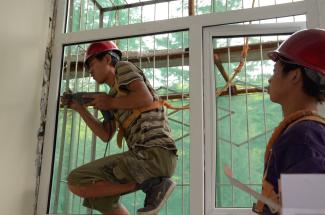Energy-efficient buildings
China can save 40 % of its heating energy

The Zhutangzhuang School in the Chinese city of Tianjin stands out. The modern four-storey building towers above old houses, farms and small factories, some of which are abandoned. Tianjin is growing quickly. To accommodate its many new residents, the city wants to demolish the old buildings to make room for a new complex of high-rise apartments – with a modern school in the middle.
The school’s walls are insulated with 10-centimetre-thick rock wool plates, its double-paned windows are filled with argon gas, and panels shield the edges of the roof from wind, rain and ice. “We were able to reduce the amount of heating energy from 110 kilowatt hours per square metre to 49 kilowatt hours per square metre,” said Zhang Shecan, director of the project “Energy efficiency in public buildings”, which the German development agency GIZ is carrying out on behalf of Germany’s Federal Ministry for Economic Cooperation and Development (BMZ). The renovations resulted in energy savings of 64 %.
Building energy consumption stands to triple
Like in Germany, buildings in China account for about 40 % of the country’s total energy consumption. Experts predict that energy use in buildings will triple by 2030. China’s buildings use almost twice as much energy per square metre to heat as European buildings. But that also means that the potential for savings is particularly great. China could save 40 % of its heating energy, which adds up to 97 million tons of carbon a year. By comparison, Germany’s total carbon emission amounted to 912 million tons in 2014.
The energy efficiency of buildings has long played a minor role in China. “We only solved problems as they arose. For instance, we would replace the windows in some buildings or the heating systems in others,” said Yuqing Bao, the technical director of the large residential construction company Beijing Uni-Construction Group (BUCC). “But we lacked a comprehensive approach that encompassed building envelopes, heating systems, warm water and lighting.” According to Bao, BUCC was finally able to develop such an approach through its cooperation with GIZ.
In the Huixin Xili district of Beijing, the BUCC renovated three 20-storey buildings. GIZ has initiated similar pilot programmes in Tangshan and Urumqi. Doing so required a lot of groundwork. One challenge was that many of the responsible ministries, construction companies and architecture firms did not understand the need for energy-efficient retrofitting. High-quality windows, insulation materials and heating systems also had to be acquired.
The power of positive examples
Pilot projects play an important role. Nothing is more convincing than an example of a practical and successful renovation. “When we talked to the residents of Tangshan prior to the renovation, they were afraid that costs would go up without any real improvements,” recalled Alfred Kerschberger, an architect and inspector for the German-Chinese projects. “But after they spent their first winter in the renovated apartments, all of their doubts disappeared. The residents of neighbouring buildings even requested that the city retrofits their apartments as well.”
Pilot projects are a very valuable tool in places where norms, standards, regulations or laws are not yet in place. Successful projects are also useful when the renovation methods that are tested on individual buildings can be applied on a larger scale. Both of these conditions are met in China. For instance, the city of Tangshan is renovating its existing buildings according to the German-Chinese approach. So far it has retrofitted 6 million square metres of building area. The German KfW Development Bank is working with other banks in the city to finance the renovation of 150 additional buildings, which together house almost 10,000 apartments.
“The German-Chinese pilot projects have laid the groundwork for the large-scale renovation of buildings in northern China,” said Han Aixing, the deputy director for building energy and technology in China’s Ministry of Construction.
Renovation concepts based on building type
But which buildings should be retrofitted first? Which measures are cost-effective, and which ones save the most energy? In order to answer these questions, the Ministry of Construction and GIZ identified 22,500 buildings in need of renovation in three northern Chinese cities and classified them according to type. Next, the German and Chinese experts developed specific renovation plans for each category of building.
These renovation plans are now available to all of the construction authorities in northern China. They allow decision-makers to quickly determine where and how the maximum reduction of energy use and emissions can be achieved using the available resources. Developers can rely on the plans to calculate the cost of heating prior to renovation and thereby determine the potential savings. On this basis, China intends to establish a trading platform for carbon emissions that would function according to rules similar to the Clean Development Mechanism of the Kyoto Protocol.
Public buildings, especially hospitals, consume an above-average amount of heat and electricity. With support from GIZ, Chinese experts are determining the energy consumption of selected schools and hospitals in three climate zones, developing design plans for renovations based on pilot projects and sharing their experiences through technical guides, symposia, workshops and educational trips.
The Zhutangzhuang School in Tianjin is an example of these efforts. Since its renovation in the summer of 2012, education and construction authorities, engineers and architects visit the school regularly to learn more about its energy-saving measures. For GIZ, collaborating with Chinese experts is important in order to spur further renovations.
Government regulations and support
Since 2006, China has evaluated building standards using the Green Building Evaluation Standard. The government provides a subsidy of up to 80 CHY (about € 12) per square metre for certified buildings (mostly new constructions). Developers who retrofit existing buildings receive up to 55 CHY (about € 8). The government has also established binding regulations for the energy efficiency of public and residential buildings. By the end of this year, public buildings in China will be required to use 12 % less energy than they did five years ago.
China’s Ministry of Construction reports that it has renovated more than 900 million square metres of building area since 2008, thereby reducing carbon emissions by at least 25 million tons a year. However, China’s total building area comprises roughly 50 billion square metres. “We draw inspiration from German ideas. But we also have to consider how many buildings we have. If we worked at Germany’s pace, it would take a hundred years to retrofit them all. So we are adapting our standards to fit our needs and are renovating as many buildings as we can in a short time,” explained Yang Fuli, the division head of the Construction and Traffic Commission in Tianjin.
Higher standards make perfect sense. “If the ministry requires more efficient windows, they can be mass-produced cost-effectively in order to avoid higher costs,” argued Zhang Shecan. There are many high-quality construction materials available now in China, he added. Renovations must be done diligently to realise the savings that architects project. The workers are frequently under-qualified however.
Nevertheless, Zhang Shecan believes that China is on the right path: “Twenty years ago, efficiency standards for buildings played no role. Today, most officials understand their advantages.” According to him, many passive-energy buildings can now be found throughout the vast country.
Marian Rzepka is GIZ’s senior planning specialist for energy efficiency.
marian.rzepka@giz.de
Link:
GIZ project in China: Energy efficiency in public buildings (schools and hospitals).
https://www.giz.de/en/worldwide/30620.html











